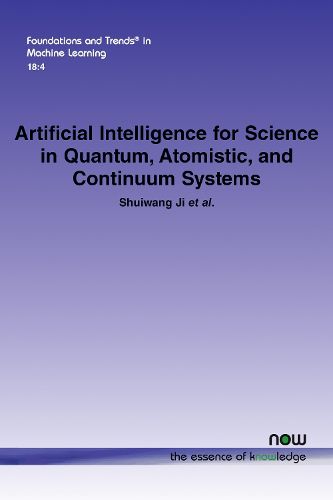Readings Newsletter
Become a Readings Member to make your shopping experience even easier.
Sign in or sign up for free!
You’re not far away from qualifying for FREE standard shipping within Australia
You’ve qualified for FREE standard shipping within Australia
The cart is loading…






This title is printed to order. This book may have been self-published. If so, we cannot guarantee the quality of the content. In the main most books will have gone through the editing process however some may not. We therefore suggest that you be aware of this before ordering this book. If in doubt check either the author or publisher’s details as we are unable to accept any returns unless they are faulty. Please contact us if you have any questions.
Decades of artificial intelligence (AI) research have culminated in the renaissance of neural networks under the name of deep learning. Intensive research has led to many breakthroughs in this area, including, for example, ResNet, diffusion and score-based models, attention, transformers, and recently large language models (LLM) and ChatGPT. These developments have led to continuously improved performance for deep models. When coupled with growing computing power and large-scale datasets, deep learning methods are becoming dominant approaches in various fields, such as computer vision and natural language processing. Propelled by these advances, AI has started to advance natural sciences by improving, accelerating, and enabling our understanding of natural phenomena at a wide range of spatial and temporal scales, and giving rise to a new area of research known as AI for science (AI4Science). Being an emerging research paradigm, AI4Science is unique in that it is an enormous and highly interdisciplinary area. Thus, a unified and technical treatment of this field is needed, yet challenging.
This monograph provides a technically thorough account of a subarea of AI4Science; namely, AI for quantum, atomistic, and continuum systems. These areas aim to understand the physical world from the subatomic (wave functions and electron density), atomic (molecules, proteins, materials, and interactions), to macro (fluids, climate, and subsurface) scales and form an important subarea of AI4Science. A unique advantage of focusing on these areas is that they largely share a common set of challenges, thereby allowing a unified and foundational treatment. A key common challenge is how to capture physics first principles, especially symmetries, in natural systems by deep learning methods. An in-depth yet intuitive account of techniques to achieve equivariance to symmetry transformations is provided. Other common technical challenges, including explainability, out-of-distribution generalization, knowledge transfer with foundation and large language models, and uncertainty quantification, are also discussed. To facilitate learning and education, categorized lists of resources that we found to be useful are provided. The presentation is thorough and unified and it is hoped that this initial effort may trigger more community interests and efforts to further advance AI4Science.
$9.00 standard shipping within Australia
FREE standard shipping within Australia for orders over $100.00
Express & International shipping calculated at checkout
Stock availability can be subject to change without notice. We recommend calling the shop or contacting our online team to check availability of low stock items. Please see our Shopping Online page for more details.
This title is printed to order. This book may have been self-published. If so, we cannot guarantee the quality of the content. In the main most books will have gone through the editing process however some may not. We therefore suggest that you be aware of this before ordering this book. If in doubt check either the author or publisher’s details as we are unable to accept any returns unless they are faulty. Please contact us if you have any questions.
Decades of artificial intelligence (AI) research have culminated in the renaissance of neural networks under the name of deep learning. Intensive research has led to many breakthroughs in this area, including, for example, ResNet, diffusion and score-based models, attention, transformers, and recently large language models (LLM) and ChatGPT. These developments have led to continuously improved performance for deep models. When coupled with growing computing power and large-scale datasets, deep learning methods are becoming dominant approaches in various fields, such as computer vision and natural language processing. Propelled by these advances, AI has started to advance natural sciences by improving, accelerating, and enabling our understanding of natural phenomena at a wide range of spatial and temporal scales, and giving rise to a new area of research known as AI for science (AI4Science). Being an emerging research paradigm, AI4Science is unique in that it is an enormous and highly interdisciplinary area. Thus, a unified and technical treatment of this field is needed, yet challenging.
This monograph provides a technically thorough account of a subarea of AI4Science; namely, AI for quantum, atomistic, and continuum systems. These areas aim to understand the physical world from the subatomic (wave functions and electron density), atomic (molecules, proteins, materials, and interactions), to macro (fluids, climate, and subsurface) scales and form an important subarea of AI4Science. A unique advantage of focusing on these areas is that they largely share a common set of challenges, thereby allowing a unified and foundational treatment. A key common challenge is how to capture physics first principles, especially symmetries, in natural systems by deep learning methods. An in-depth yet intuitive account of techniques to achieve equivariance to symmetry transformations is provided. Other common technical challenges, including explainability, out-of-distribution generalization, knowledge transfer with foundation and large language models, and uncertainty quantification, are also discussed. To facilitate learning and education, categorized lists of resources that we found to be useful are provided. The presentation is thorough and unified and it is hoped that this initial effort may trigger more community interests and efforts to further advance AI4Science.